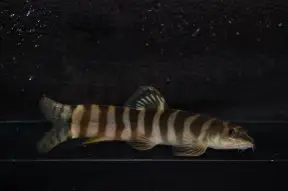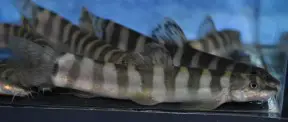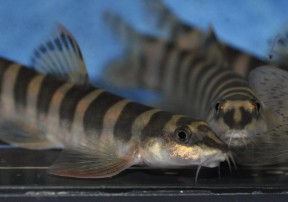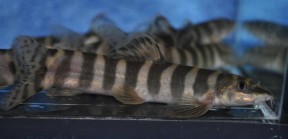Schistura hypsiura
Super Convict Loach
Etymology
Schistura: from the Ancient Greek σχῐ́ζω (skhízō), meaning ‘to split, cleave’, and οὐρά (ourá), meaning ‘tail’, in reference to the bilobate caudal-fin shape of the type species.
hypsiura: from the Ancient Greek ὕψος (húpsos), meaning ‘high’, and οὐρά (ourá), meaning ‘tail’, in reference to this species’ high caudal peduncle.
Classification
Order: Cypriniformes Family: Nemacheilidae
Distribution
Currently known only from the type locality in southern Rakhine State, western Myanmar.
Type locality is ‘Myanmar: Rakhine State: Kyeinthali Chaung at Ka La Byin, about 17°56’N, 94°30’E’.
Habitat
The type locality is described as a short coastal river.
Maximum Standard Length
The largest specimen in the type series measured 73.4 mm.
Aquarium SizeTop ↑
Minimum base dimensions of 80 ∗ 30 cm or equivalent should prove sufficient.
Maintenance
Not difficult to maintain under the correct conditions; we strongly recommend keeping it in a tank designed to resemble a flowing stream or river with a substrate of variably-sized rocks, sand, fine gravel, and some water-worn boulders.
This can be further furnished with driftwood branches arranged to form a network of nooks, crannies, and shaded spots, thus providing broken lines of sight. While the majority of aquatic plants will fail to thrive in such surroundings hardy types such as Microsorum, Bolbitis, or Anubias spp. can be grown attached to the décor.
Though torrent-like conditions are unnecessary it does best if there is a high proportion of dissolved oxygen and some water movement in the tank meaning power filter(s), additional powerhead(s), or airstone(s) should be employed as necessary.
Like many fishes that naturally inhabit running water it’s intolerant to accumulation of organic pollutants and requires spotless water in order to thrive, meaning weekly water changes of 30-50% tank volume should be considered routine.
Water Conditions
Temperature: 18 – 24 °C
pH: 6.0 – 7.5
Hardness: 36 – 215 ppm
Diet
Schistura species are omnivorous although the bulk of their diet consists of small insects, worms, crustaceans, and other zooplankton, with only relatively small amounts of plant matter and other organic detritus consumed.
In the aquarium they will accept dried foods of a suitable size but should not be fed these exclusively. Daily meals of small live and frozen fare such as Daphnia, Artemia, chironomid larvae (bloodworm), etc., will result in the best colouration and condition.
Behaviour and CompatibilityTop ↑
Not among the more aggressive members of the genus and can be maintained in a community aquarium provided tankmates are selected with care and proper research.
Fishes which inhabit similar biotopes in nature, especially pelagic cyprinids, perhaps constitute the best options, and one or two schools can make a visible difference to the confidence of benthic species. Other possibilities include rheophilic loaches and benthic cyprinids. Similarly-shaped relatives aren’t recommended under most circumstances although a combination may work in larger aquaria.
Though not gregarious in the sense of schooling or shoaling fishes it does seem to do best in the presence of conspecifics and provided plenty of cover is available any aggression should be minimal.
Sexual Dimorphism
Males possess a a triangular suborbital flap with a rounded posteroventral tip, which has an additional lateral extension in larger individuals, and females larger than ~ 45 mm SL possess a suborbital groove. These features are absent in juveniles. Sexually mature females are also likely to appear heavier-bodied than males.
Reproduction
Unrecorded.
NotesTop ↑
This species has been traded as S. sp. ‘super convict’ in the ornamental market.
It can be distinguished from congeners by the following combination of characters: caudal peduncle deep, ≥ the deepest part of the remainder of the body; no dorsal or ventral skin crests along the caudal peduncle; caudal-fin deeply forked, the outermost principal rays in the upper and lower lobes more than twice the length of the innermost: adult male with a suborbital flap; adult female with a well-developed suborbital groove; 6–8 very regular bars along the flank.
Schistura is the most species-rich genus among nemacheilid loaches with some 190 members and it continues to grow with over 100 having been described since 1990. It may represent a polyphyletic lineage and is often arranged into a number of loosely-defined species ‘groups’, some of which are quite dissimilar to one another.
Among these are an assemblage in which some or all of the body bars are vertically split, and another which exhibit reductions in body size (adult size <50 mm SL), the number of pelvic and pectoral-fin rays and often the number of caudal-fin rays and lateral line length. Some individual species, such as S. geisleri, also appear to be unrelated to any of the others.
Most inhabit flowing streams or areas close to waterfalls where there naturally exist high concentrations of dissolved oxygen, and a handful are troglobytic, i.e., cave-dwelling, in existence. The latter have reduced pigmentation and are completely blind in many cases.
Schistura spp. are distinguished from other nemacheilids by a combination of morphological characters which include: a moderately arched mouth which is 2-3.5 times wider than it is long; a median ‘interruption’ in the lower lip which does not form two lateral triangular pads and can vary from smooth to furrowed in texture; diverse colour pattern but usually dark with relatively regular bars; usually a black bar at the caudal-fin base which can be broken into two spots or smaller bars; one or two black markings along the base of the dorsal-fin; lack of acuminate scales on the caudal peduncle; caudal-fin shape variable from truncate to forked but usually emarginate; presence or absence of a median notch in the lower jaw; clear sexual dimorphism in some species.
The family Nemacheilidae is widely-distributed across most of Eurasia with the Indian subcontinent, Southeast Asia and China representing particular centres of species diversity.
References
- Bohlen, J., V. Ŝlechtová and K. Udomritthiruj, 2014 - Raffles Bulletin of Zoology 62: 21-27
Schistura hypsiura, a new species of loach (Cobitoidea: Nemacheilidae) from south-west Myanmar. - Bănărescu, P. M. and T. T. Nalbant, 1995 - Travaux du Muséum d'Histoire Naturelle 'Grigore Antipa' 35: 429-495
A generical classification of Nemacheilinae with description of two new genera (Teleostei: Cypriniformes: Cobitidae). - Kottelat, M., 1990 - Verlag Dr. Friedrich Pfeil, München: 1-262
Indochinese nemacheilines. A revision of nemacheiline loaches (Pisces: Cypriniformes) of Thailand, Burma, Laos, Cambodia and southern Viet Nam. - Tang, Q., H. Liu, R. Mayden, and B. Xiong, 2006 - Molecular Phylogenetics and Evolution 39(2): 347-357
Comparison of evolutionary rates in the mitochondrial DNA cytochrome b gene and control region and their implications for phylogeny of the Cobitoidea (Teleostei: Cypriniformes). - Šlechtová, V., J. Bohlen and H. H. Tan, 2007 - Molecular Phylogenetics and Evolution 44(3): 1358-1365
Families of Cobitoidea (Teleostei; Cypriniformes) as revealed from nuclear genetic data and the position of the mysterious genera Barbucca, Psilorhynchus, Serpenticobitis and Vaillantella.





September 1st, 2015 at 1:58 pm
Hi Matt, this is Schistura hypsiura from Rakhine state. See the open access description in Raffles Bulletin of Zoology 62.
September 4th, 2015 at 4:02 pm
This is now fixed. Thank you very much for the positive id Jörg.